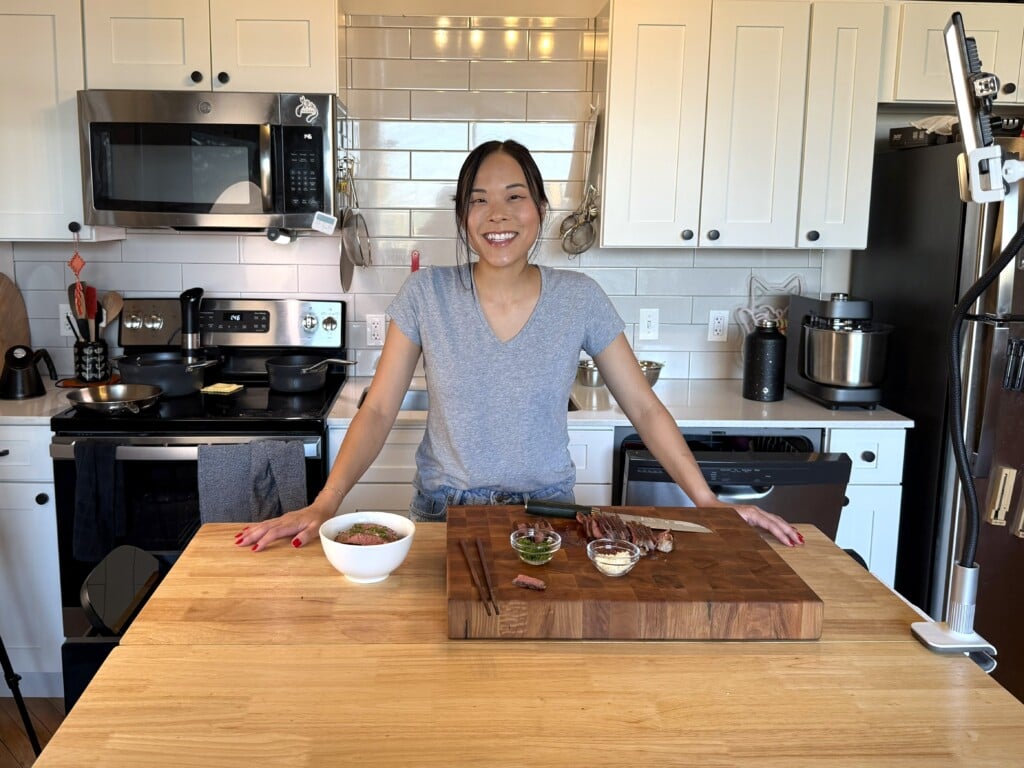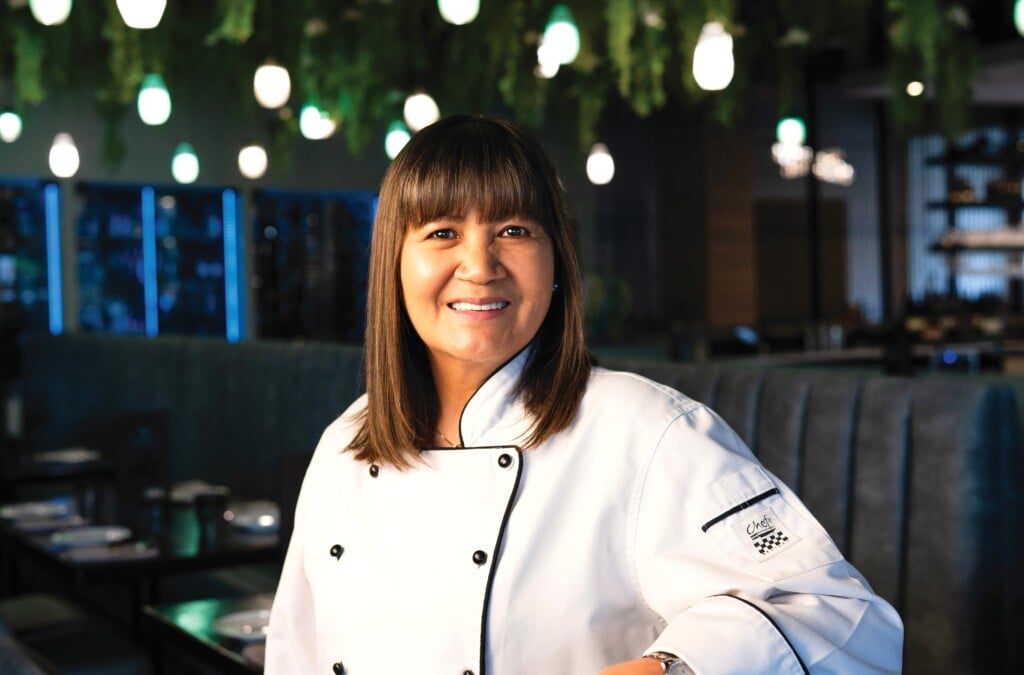Snap Snap

My friend Linda just returned from a trip to Shanghai, which turned out to be an eating extravaganza. “You can’t even imagine the number of restaurants there,” she said. “They’re practically on top of each other, and one is more fabulous than the next. Going out to eat is a big part of the social scene there. A Chinese friend of mine said that in Shanghai, people start thinking about what they’re going to eat for lunch while they’re eating breakfast.”
Doesn’t everybody? When Linda described the stellar restaurants she visited, some of the details resonated: visually striking food, minimalist décor, theatrical lighting. It sounded a little like Red Snapper.
Unlike Shanghai restaurants, however, Red Snapper offers a pan-Asian menu — which is very hot in the States right now. Why settle for an old-fashioned Cantonese joint when you can choose from a more imaginative menu that mixes up traditional Cantonese, Szechwan and Hunan dishes with Vietnamese, Thai and Korean fare?
That brings us to the Chao brothers, Max and Kua-Ching (better known as Casey). They immigrated to Kansas City from South Korea with their Chinese-born parents in 1979. Three years later, the Chaos’ parents opened their first little Chinese restaurant, Peking, at 36th Street and Broadway. Max and Casey grew up cooking traditional Cantonese, Szechwan and Chinese-American dishes in the kitchen of that restaurant and, later, at the family’s bigger, more elaborate New Peking Restaurant in Westport.
The Chao brothers later took over the New Peking from their parents and sold it in 2003 so they could follow their own divergent culinary paths. For more than two years, Max operated Max’s Noodles & More, a modest pan-Asian venue near 17th Street and Main; now he’s opening a Hawaiian barbecue joint (see My Big Fat Mouth, page 38). Casey had a grander vision and poured some serious money into a new strip-mall space just north of the Ward Parkway shopping center.
When I first reviewed the Red Snapper (“The Yuan and the Restless,” December 4, 2003), I worried that the fortunes of Casey’s slickly designed bistro might be hurt by its location — the neighborhood hadn’t seen a successful restaurant since Costello’s Greenhouse in the 1980s. There was also a problem with the name: It sounded too much like a lowbrow seafood chain. In fact, when I invited my friend Judy and her daughter, Carrie, to join me for dinner, I had to explain that Red Snapper had no connection to Red Lobster.
Most customers have figured that out by now, and Casey’s place has found its groove. Gone are a couple of early menu items, including the Mandarin meatball and the Peking duck. Servers are more polished and professional (with fewer piercings). And instead of being cursed by its location, Red Snapper has thrived. “It’s our neighborhood restaurant,” says a friend of mine who lives in nearby Leawood. “It’s five minutes from our house, and we can make a great meal out of soup and several appetizers.”
I’m not one of those people who can rationalize eating an appetizer and calling it dinner. But Red Snapper has a couple of options that might change my mind — particularly skewers of lusciously caramelized beef tenderloin, and spring rolls plumped up with shrimp and chopped basil. I have friends and co-workers who swear by this restaurant’s signature rangoon, a wonton-wrapped pouch of cream cheese and smoked salmon, but three years after I first sampled this concoction, it still doesn’t taste much different from the crab version — it’s all about the cream cheese.
I ran a bit hot and sour on Casey Chao’s food back in 2003, but I’m hotter for it now. Chao still mixes up familiar Chinese-American favorites (General Tso’s chicken, orange-flavored beef, lo mein) with a couple of Thai dishes, a few Japanese-inspired offerings and a Korean stir-fry. The execution, however, is vastly superior.
[page]
Taking a cue from the Cheesecake Factory’s novella-sized menu, Chao has gone from a legal-sized sheet of heavy-stock paper to a vinyl-covered spiral-bound book — complete with two pages of “credits,” just like at the end of a movie, only here acknowledging a lawyer, an acupuncture specialist, a jeweler and a dozen other business owners. You can’t have too many friends, after all.
And on that note, the place attracts a steady bar crowd, too. Sangria was the cocktail special on the night I dined with Judy and Carrie, and they both ordered glasses of the fruity Spanish wine punch. “It’s surprisingly good,” said Carrie, who had worried that the drink would be some prepackaged affair. “But I think it has a splash of Sprite in there.”
What better to accompany a Spanish wine cooler than an Asian vegetable medley — bamboo shoots, red peppers, onions, bean sprouts and fresh basil — and slices of sautéed duck breast? Carrie thought the entrée was quite tasty, but as a professional chef herself, she wished the kitchen had been less aggressive about searing the duck. She prefers her meat on the rare side, but I reminded her that in Kansas City, medium-rare is rare.
Judy snapped up the restaurant’s namesake dish, which, after three years, is still one of the best things about this place: a whole red snapper that’s breaded and wok-fried, head bones and all, until the crust is amber and crispy, the flesh white and flaky. Chao’s kitchen staff puts out three versions of fried snapper, but I’m partial to the one splashed with a basil, garlic and jalapeño sauce and smothered with fresh vegetables. It packs a punch, but the fiery sauce complements the fish as well as the generous mound of broccoli, asparagus, fresh bamboo shoots and bell peppers.
Red Snapper’s Kun Pun Gi is even spicier, but it’s a sensual fire. Pieces of chicken breast are lightly breaded, fried with dried chili-pepper flakes and finished off with a translucent chili sauce, more sweet than hot.
A few days after having dinner with Judy and Carrie, I returned for lunch with Ned and Lynn; we decided to pass on the lunch specials, which weren’t especially cheap and reminded us of old-fashioned Chinese restaurants (Polynesian-style sweet-and-sour shrimp, kung pao chicken). Instead, we sampled offerings from the slightly costlier dinner menu. The soups are terrific here — even the plebeian egg-drop soup is a classy affair. It’s not neon yellow and thick with cornstarch; instead, it’s a heavenly, light broth in which crunchy bits of chopped celery and water chestnuts float alongside scallions and tiny cubes of milky tofu.
Lynn wanted something light, so she nibbled on a salad topped with grilled chicken (and, at her request, airy squares of fried tofu) and a delightfully clean-tasting lime-peanut vinaigrette. Ned ordered the Thai-coconut red curry stir-fry and was disappointed that it didn’t look like any red curry dish he’d ever seen. The silken coconut-milk sauce wasn’t red at all but ivory, comparable to an Alfredo sauce —sweeter but just as creamy. “It’s Asian comfort food,” Lynn said after snagging a sliver of the grilled beef. There was barely a hint of curry, but it was an addictive mixture with lots of peppers, asparagus and edamame bobbing in its cloudy depths.
[page]
I was happy to trade lunches with Ned, who had greedily eyed my spicy Korean stir-fry. The secret of this dish wasn’t the garlicky pieces of grilled chicken or the chopped mushrooms and zucchini but its glaze: a glossy, firecracker-red sauce made with Korean chili paste.
We opted not to order dessert (they’re mostly weird, factory-made pastries anyway, including a tube of fried cheesecake), which was fine with me because I didn’t particularly care whether lunch ended on a sweet note.
Dinner, on the other hand, is a different story. And because I’m usually thinking about my evening meal while I’m eating lunch, deep-fried cheesecake suddenly didn’t sound that bad.




